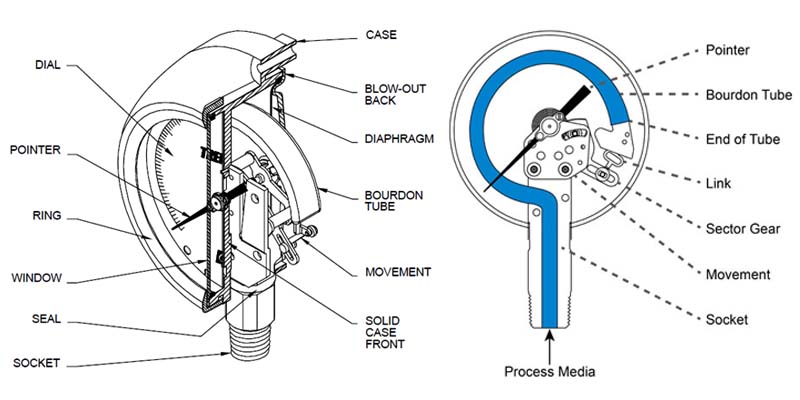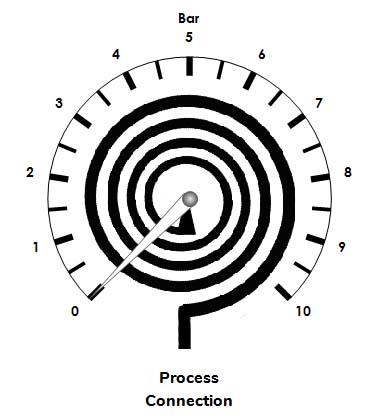Table of Contents
What is Bourdon Tube Pressure Gauge?
Introduction
The bourdon tube is a circular shape tube, generally bent over an angle around 270°, with one end close and the other end is connected to the process pressure.
When the pressure is applied to one end of the bourdon tube, the other end, which is closed, can move freely. This movement can be amplified with the use of a rack and pinion to the pointer gauge of the bourdon tube.
Construction

The bourdon tube behaves like a spring which is deformed when pressurized. Thus the elasticity of the tube is an important factor and mainly depends on the below factors:
- The tube wall thickness
- The shape of the tube cross-section
- The diameter of the C-Shape
- The kind of material from which tube is manufactured
A bourdon tube is usually flattened on one end or both ends, this allows the tube to lose some of its rigidity which makes it easier to uncoil when pressurized.
A larger wall thickness is required to measure the high pressure. The bourdon tube is generally used to measure the pressure from the 0.6 bar to 7000 bar.
Temperature effect on the bourdon tube
The tube will become stiffer and more difficult to straighten at low temperatures. Therefore the material of the coil should be well chosen to minimalize the temperature effect.
Fast response and good sensitivity are the most desirable features of the bourdon tube.

Generally, a bourdon tube pressure gauge is mounted vertically. While measuring the pressure of a liquid, a bourdon tube gauge will be filled with the liquid to trap the air at one end.
A liquid is also filled in the bourdon tube indicator to dampen the small movement of the pointer due to high vibration. Glycerine is generally used for this purpose.
The fluid-filling bourdon tube indicator also prevents humidity from entering the enclosure. When the ambient temperature fluctuates, it will create a “breathing effect”. Humid ambient air comes in at low temperatures and goes out at high temperatures. All of this was avoided by filling the gauge with glycerine.
Types of Bourdon Tube
Spiral type Bourdon Tube

Unlike the C-shaped tube, the spiral-type bourdon tube consists of multiple windings in one plane. Due to the multiple winding, when the coil is pressurized it has a larger displacement as compared to a C-shaped tube.
In the spiral-type bourdon tube, the tube is directly connected with the pointer. There is no need for a transmission mechanism. The numbers of windings should be determined correctly for the selected measuring range.
Having a fixed link makes the spiral-type Bordon tube more accurate. There is less transmission loss due to friction or backlash. Even it has a good resistivity to vibration and pulsation.
The spiral-type bourdon tube is made of a flat oval tube to measure low pressure and a round tube to measure high-pressure ranges. Generally, a spiral-type bourdon tube is used to measure high pressure which cannot be measured with the C-shaped tube.

Image Credit: tec-science.com
Helical type Bourdon Tube

Image Credit: fluidpowerworld.com
In this type of bourdon tube, there are several turns winded into a helix. The number of turns can vary from two or three to twenty.
When there are two or three turns, it needs a transmission mechanism to amplify the pressure signal. For more windings there is no need for a transmission mechanism as the displacement will be larger for more windings.
The measurement range does not only depend on the windings but also on the wall thickness and material used to build the bourdon tube.
Helical type bourdon tube is generally used to measure high-pressure measurement ranges.
Advantages and Disadvantages of Bourdon Tube
There are several advantages of the bourdon tube pressure gauge, which makes it easier to use in industrial and domestic applications.
- The result of the bourdon tube is accurate.
- They are simple in construction.
- The cost of the bourdon tube pressure gauge is low.
- They are easy to install and use for high-pressure measurement applications.
- They have high repeatability.
Despite being several advantages, the bourdon tube pressure gauge has some limitations. Such as,
- They respond slowly to changes in pressure
- They are subjected to hysteresis.
- They are sensitive to shocks and vibrations.
- Amplification is a must as the displacement of the free end of the bourdon tube is low.
You can read more articles about Electrical and you can also find books that boost your knowledge in the field of Instrumentation ⇒
Thanks for reading!
